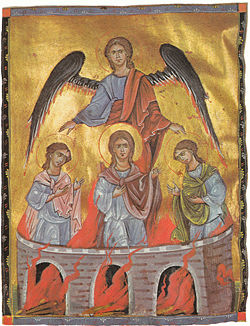Top Qs
Timeline
Chat
Perspective
December 17 (Eastern Orthodox liturgics)
Day in the Eastern Orthodox liturgical calendar From Wikipedia, the free encyclopedia
Remove ads
December 16 - Eastern Orthodox liturgical calendar - December 18

All fixed commemorations below celebrated on December 30 by Orthodox Churches on the Old Calendar.[note 1]
For December 17th, Orthodox Churches on the Old Calendar commemorate the Saints listed on December 4.
Saints
- Holy Prophet Daniel (600 BC)[1] and the Three Holy Youths: Ananias, Azarias, and Misael.[2][note 2]
- Monk-martyrs Patermuthius and Coprius, and Martyr Alexander the Soldier, of Egypt (361-363)[3][4]
- Martyr Bacchus (Iakchos), from Triglia, by the sword.[5][6][7]
- Venerable Daniel the Confessor (Stephen the Confessor in schema) of Spain and Egypt (10th century)[4][8][note 3]
- Saints Athanasius, Nicholas, and Anthony, disciples of Athanasius the Athonite and founders of Vatopedi monastery, Mt. Athos (10th century)[4][10]
Remove ads
Pre-Schism Western saints
- Saint Maxentiolus (Mezenceul), a disciple of St Martin of Tours in France, he founded Our Lady of Cunault (5th century)[11]
- Saint Tydecho of Wales, brother of Saint Cadfan (6th century)[11][note 4]
- Saint Briarch, born in Ireland, became a monk in Wales with St Tudwal, whom he accompanied to Brittany, built a monastery in Guingamp and reposed in Bourbiac (c. 627)[11]
- Saint Judicaël, son of Hoel and king of Domnonia and Brittany, much loved by his people, spent the last twenty years of his life in the monastery of Gäel near Vannes (658)[11]
- Saint Begga, founder and Abbess of a convent in Andenne on the Meuse in Belgium (698)[11][note 5]
- Saint Sturm (Sturmius), Abbot and Apostle of Saxony, founder of Fulda Monastery (Germany) (779)[4][10][11][note 6]
- Saint Eigil of Fulda, the fourth abbot of Fulda (822)[11]
Remove ads
Post-Schism Orthodox saints
- New Martyr Nicetas of Nyssa (c. 1300)[4][6][12]
- Saint Dionysios of Zakynthos, Archbishop of Aegina (1624)[4][13][14]
- Saint Misael of Abalatsk, Hieromonk (1797)[4][10]
- New Hieromartyrs Paisius, Abbot of Trnava (Turnovo), Cacak (1814),[15] and Abbacum, Deacon (1815),[16] at Belgrade.[4][10]
New martyrs and confessors
- New Hieromartyr Sergius Florinsky, Priest of Rakvere, Estonia (1918)[4][10][17][note 7] (see also: July 2 )
- New Hieromartyr Nicholas Beltiukov, Protopresbyter of Perm (1918)[6][10][17]
- New Hieromartyr Alexander Savelov, Priest of Perm (1918)[6][10][17]
- New Hieromartyr John Zemlyani, Priest of Alma-Ata (1937)[6][10][17]
- New Hieromartyr Peter Pokrovsky, Priest (1937)[6][10][17]
Other commemorations
- Repose of Elder Hadji George of Mt. Athos (1886)[4]
- Repose of Hiero-schemamonk Daniel (Sandu Tudor), poet of Romania (1962)[4]
- Repose of lay elder Panagis of Ilami, Cyprus (1989)[4]
Icon gallery
- Icon of the Prophet Daniel.
- Russian icon of Daniel in the lions den (17th century)
- Stained glass window of Daniel in the lions den (Chartres).
- The Three Holy Youths: Ananias, Azarias, and Misael (Mashtots, 1266).
- The Three Holy Youths: Ananias, Azarias, and Misael (Catacombs of Priscilla, Rome, Italy. Late 3rd century)
- Entrance to church of St. Tydecho, Llanymawddwy, Wales.
- Crop of a painting of St. Judicaël.
- Stained glass of St. Judicaël.
- St. Begga.
- Saint Sturm, Apostle of Saxony, represented on a 1 Mark banknote, 1921.
- Sandu Tudor (Brother Agathon, Father Daniil Teodorescu).
Remove ads
Notes
- The notation Old Style or (OS) is sometimes used to indicate a date in the Julian Calendar (which is used by churches on the "Old Calendar").
The notation New Style or (NS), indicates a date in the Revised Julian calendar (which is used by churches on the "New Calendar"). - The song of the three youths is alluded to in odes seven and eight of the canon, a hymn sung in the matins service and on other occasions in the Eastern Orthodox Church, where their feast day is December 17 (along with Daniel). The Orthodox Church also commemorates them on the two Sundays before the Nativity of Christ. The reading of the story of the fiery furnace, including the song, is prescribed for the vesperal Divine Liturgy celebrated by the Orthodox on Holy Saturday. Likewise, the three are commemorated as prophets in the Calendar of Saints of the Lutheran Church on December 17 with Daniel.
- Saint Daniel the Confessor, (in the schema Stephen) lived in the 10th century. He was a Spanish dignitary, and prefect of the island of Niverta. Disdaining worldly glory, he became a monk in Rome and went on pilgrimage to the holy places at Constantinople and Jerusalem, where he received the Great Schema and the name Stephen. He received the crown of martyrdom after he refused the Saracens' demand that he renounce Christ and become a Moslem.[9]
- He and his sister lived in Gwynedd. Several churches are dedicated to him.
- Daughter of St Pepin of Landen and St Ida and sister of two other saints. She married Angisilus (Ansegis), son of St Arnulf of Metz. After her husband's death St Begga founded a convent in Andenne on the Meuse in Belgium where she was abbess.
- As a child he was entrusted to St Boniface and brought up in the monastery of Fritzlar in Germany. Ordained, he was sent to enlighten the Saxons. He went to find a suitable site for a monastery in central Germany and chose Fulda. Sturm then went to Montecassino and on his return became Abbot of Fulda. Dearly loved by his monks, Sturm is considered as second only to Boniface as Apostle of Germany.
- See also: (in Russian) Флоринский, Сергей Фёдорович. Википедии. (Russian Wikipedia).
Remove ads
References
Sources
Wikiwand - on
Seamless Wikipedia browsing. On steroids.
Remove ads









